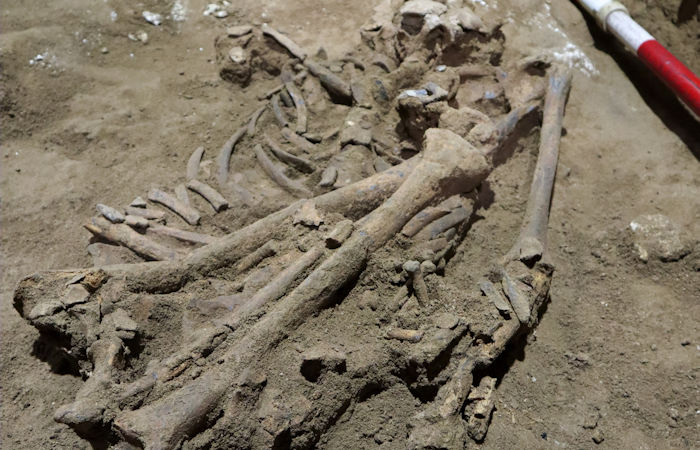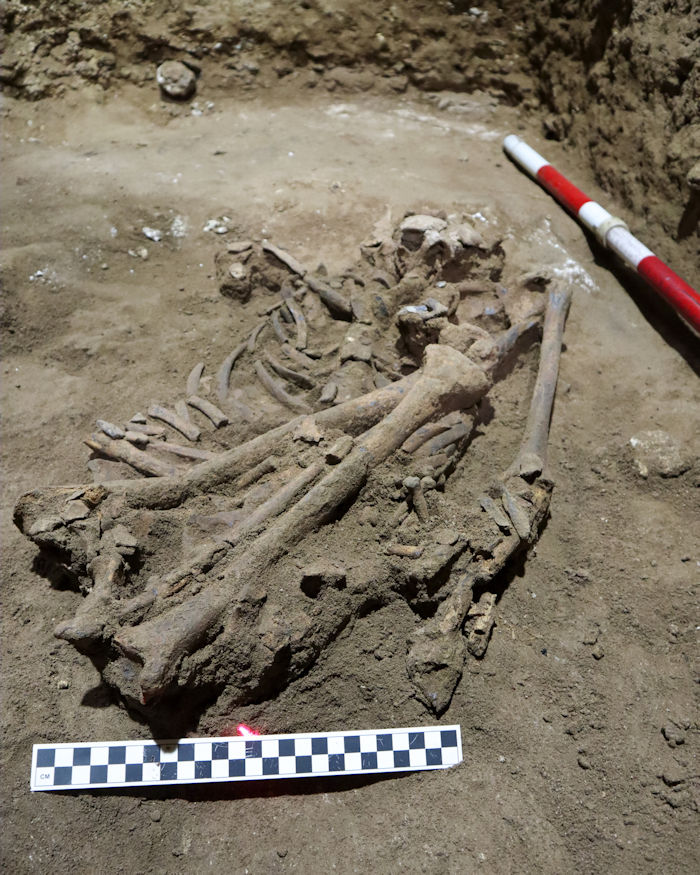Jan Bartek – MessageToEagle.com – Archaeologists have uncovered a skeleton of a person who lived 31,000 years ago. According to a new study, the individual is missing its left foot, and part of its left leg reveals the oldest known evidence of amputation.
Discovered on the island of Borneo, the remains pre-date the previously oldest known case of limb amputation by more than 20,000 years and indicate that the individual survived for several years after the surgery. The finding, published in Nature, suggests that some ancient people were proficient nurses and performed sophisticated medical procedures much earlier than scientists have thought.
The human skeleton found in Borneo, dated to about 31,000 years ago, pictured in a cave in East Kalimantan, Borneo, Indonesia is photographed on March 4, 2020. The remains, which have been dated to 31,000 years old, mark the oldest evidence for amputation yet discovered. And the prehistoric “surgery” could show that humans were making medical advances much earlier than previously thought, according to the study published Wednesday, Sept. 7, 2022 in the journal Nature. Credit: Photo Courtesy of Tim Maloney/Griffith University via AP
Archaeologists once described southeast Asia “as a cultural backwater,” says study co-author India Dilkes-Hall, an archaeologist at the University of Western Australia in Perth. “There’s always been this trope that not a lot happened there.”
This archaeological discovery is especially important as it challenges this idea, revealing that people living in Borneo were highly skilled at medicine thousands of years ago. “It’s pushing forth the right idea that this is an incredibly complex area,” adds Dilkes-Hall.
According to the study published in Nature, “the researchers found the remains in a limestone cave on the eastern side of the Indonesian part of Borneo. They uncovered an ancient grave containing a human skeleton that was surprisingly complete — except for the left foot.
“All of us were like, ‘well, where is it?’” says Dilkes-Hall.
Radiocarbon dating of charcoal found in the layers above, below and inside the grave, as well as analysis of uranium and radiation in one of the buried individual’s teeth, suggests that the person died between 31,201 and 30,714 years ago. Their age at death was estimated to be about 19 or 20 years old. The team could not determine the individual’s sex, but their height was similar to that of male individuals who are known to have lived in that time and place.
An artist’s rendering of a prehistoric individual whose lower left leg was amputated in childhood. A lump of red ochre pigment accompanied the person’s remains, which were found in a cave decorated with hand stencils.Credit: Jose Garcia (Garciartist) and Griffith University
The lower third of the person’s leg was missing, and the tibia and fibula — the bones between the knee and ankle — ended in a clean cut. This level of precision indicates that the limb was not lost in an accident or an animal attack. The bones lacked the type of mark typically left by an infection, suggesting that the wound had been cleaned and protected from contamination. Furthermore, the small size of the left tibia and fibula compared with the right ones and the healing of the bones show that the amputation occurred during childhood and at least six to nine years before death.
The left tibia (left two images) and left fibula of an individual who lived some 31,000 years ago show healed amputation sites.Credit: T. R. Maloney et al./Nature
“The probability of this happening by accident was so infinitely small that it had to be in some sort of controlled environment,” says study co-author Melandri Vlok, a bio-archaeologist at the University of Sydney in Australia.
“It is an incredible discovery,” says Cécile Buquet-Marcon, a bio-archaeologist at the French National Institute for Preventive Archaeological Research in Paris who, in 2007, described the amputation of a person’s limb that had occurred 7,000 years ago, which was at the time the oldest known evidence of this type of surgery2. She adds that the survival of the individual in Borneo indicates care-giving by the community and medical skills that few people possess even now.
See also: More Archaeology News
This proof of early human habitation in Borneo is especially important for Indonesian archaeologists, says study co-author Adhi Agus Oktaviana, an archaeologist at the National Research and Innovation Agency in Jakarta. He hopes that the study will help the United Nations cultural organization UNESCO to designate the region of the Sangkulirang–Mangkalihat Peninsula where the remains were found — also home to 40,000-year-old rock art3 — as a World Heritage Site.”
The study was published in the journal Nature
Written by Jan Bartek – MessageToEagle.com – AncientPages.com Staff Writer








